Modern Germanic languages Project was made by Dybys
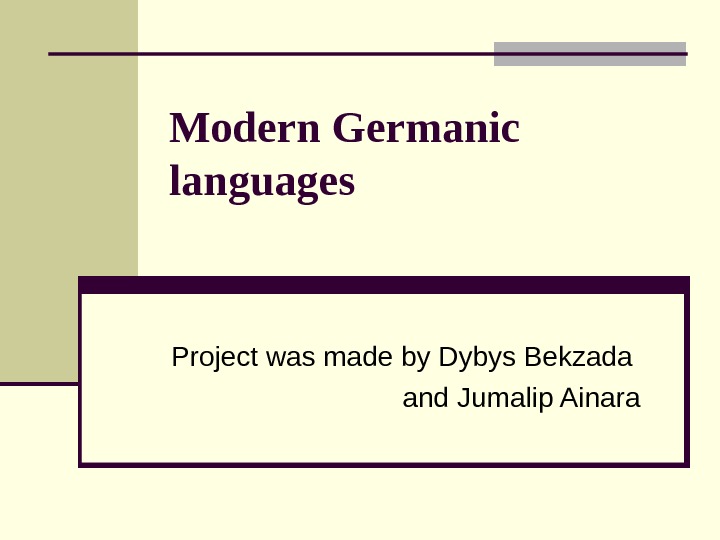
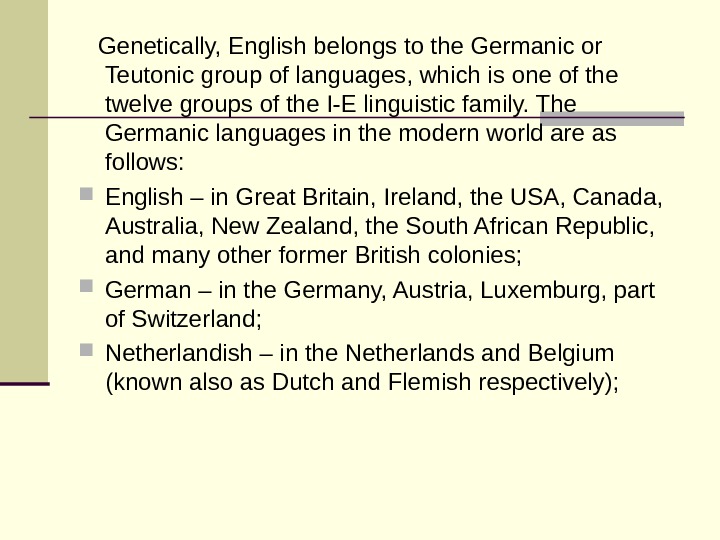


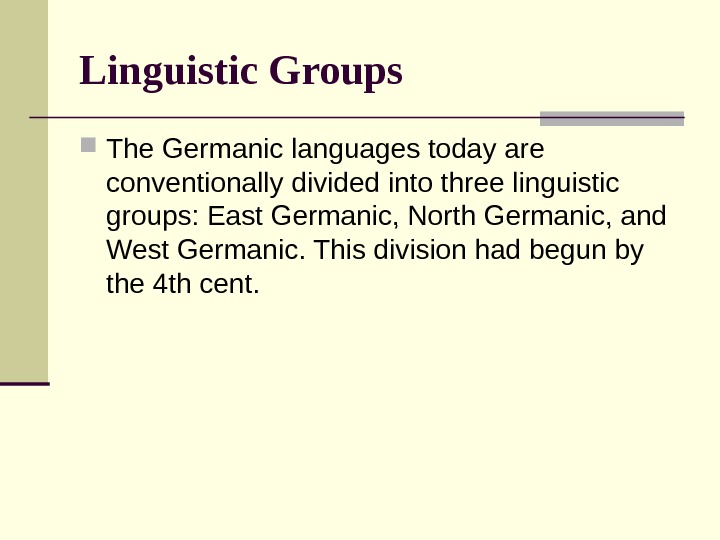
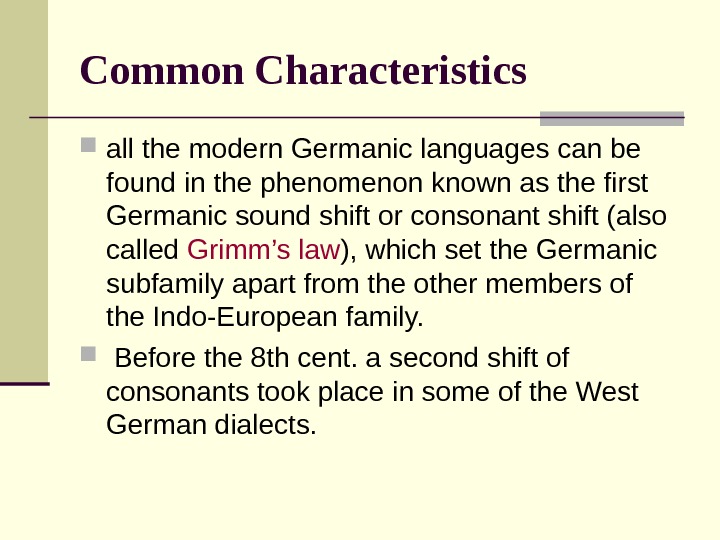
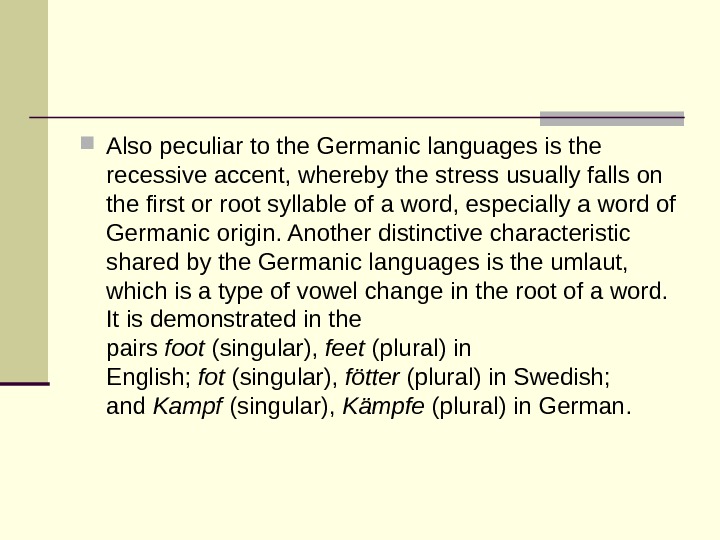
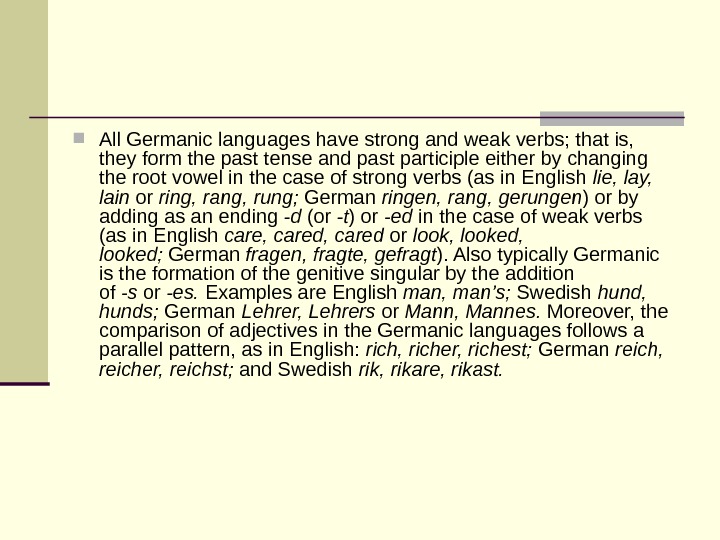

modern_germanic_languages.ppt
- Размер: 48.5 Кб
- Количество слайдов: 9
Описание презентации Modern Germanic languages Project was made by Dybys по слайдам
 Modern Germanic languages Project was made by Dybys Bekzada and Jumalip Ainara
Modern Germanic languages Project was made by Dybys Bekzada and Jumalip Ainara
 Genetically, English belongs to the Germanic or Teutonic group of languages, which is one of the twelve groups of the I-E linguistic family. The Germanic languages in the modern world are as follows: English – in Great Britain, Ireland, the USA, Canada, Australia, New Zealand, the South African Republic, and many other former British colonies; German – in the Germany, Austria, Luxemburg, part of Switzerland; Netherlandish – in the Netherlands and Belgium (known also as Dutch and Flemish respectively);
Genetically, English belongs to the Germanic or Teutonic group of languages, which is one of the twelve groups of the I-E linguistic family. The Germanic languages in the modern world are as follows: English – in Great Britain, Ireland, the USA, Canada, Australia, New Zealand, the South African Republic, and many other former British colonies; German – in the Germany, Austria, Luxemburg, part of Switzerland; Netherlandish – in the Netherlands and Belgium (known also as Dutch and Flemish respectively);
 Lists of Germanic languages given in books differ in some points, for the distinction between separate languages and also between languages and dialects varies. All the Germanic languages are related through their common origin and joint development at the early stages of history.
Lists of Germanic languages given in books differ in some points, for the distinction between separate languages and also between languages and dialects varies. All the Germanic languages are related through their common origin and joint development at the early stages of history.
 All the modern Germanic languages are closely related; moreover, they become progressively closer grammatically and lexically when traced back to the earliest records. This suggests that they all derive from a still earlier common ancestor, which is traditionally referred to as Proto-Germanic and which is believed to have broken from the other Indo-European languages before 500 B. C. Although no writing in Proto-Germanic has survived, the language has been substantially reconstructed by using the oldest records that exist of the Germanic tongue.
All the modern Germanic languages are closely related; moreover, they become progressively closer grammatically and lexically when traced back to the earliest records. This suggests that they all derive from a still earlier common ancestor, which is traditionally referred to as Proto-Germanic and which is believed to have broken from the other Indo-European languages before 500 B. C. Although no writing in Proto-Germanic has survived, the language has been substantially reconstructed by using the oldest records that exist of the Germanic tongue.
 Linguistic Groups The Germanic languages today are conventionally divided into three linguistic groups: East Germanic, North Germanic, and West Germanic. This division had begun by the 4 th cent.
Linguistic Groups The Germanic languages today are conventionally divided into three linguistic groups: East Germanic, North Germanic, and West Germanic. This division had begun by the 4 th cent.
 Common Characteristics all the modern Germanic languages can be found in the phenomenon known as the first Germanic sound shift or consonant shift (also called Grimm’s law ), which set the Germanic subfamily apart from the other members of the Indo-European family. Before the 8 th cent. a second shift of consonants took place in some of the West German dialects.
Common Characteristics all the modern Germanic languages can be found in the phenomenon known as the first Germanic sound shift or consonant shift (also called Grimm’s law ), which set the Germanic subfamily apart from the other members of the Indo-European family. Before the 8 th cent. a second shift of consonants took place in some of the West German dialects.
 Also peculiar to the Germanic languages is the recessive accent, whereby the stress usually falls on the first or root syllable of a word, especially a word of Germanic origin. Another distinctive characteristic shared by the Germanic languages is the umlaut, which is a type of vowel change in the root of a word. It is demonstrated in the pairs foot (singular), feet (plural) in English; fot (singular), fötter (plural) in Swedish; and Kampf (singular), Kämpfe (plural) in German.
Also peculiar to the Germanic languages is the recessive accent, whereby the stress usually falls on the first or root syllable of a word, especially a word of Germanic origin. Another distinctive characteristic shared by the Germanic languages is the umlaut, which is a type of vowel change in the root of a word. It is demonstrated in the pairs foot (singular), feet (plural) in English; fot (singular), fötter (plural) in Swedish; and Kampf (singular), Kämpfe (plural) in German.
 All Germanic languages have strong and weak verbs; that is, they form the past tense and past participle either by changing the root vowel in the case of strong verbs (as in English lie, lay, lain or ring, rang, rung; German ringen, rang, gerungen ) or by adding as an ending -d (or -t ) or -ed in the case of weak verbs (as in English care, cared or look, looked, looked; German fragen, fragte, gefragt ). Also typically Germanic is the formation of the genitive singular by the addition of -s or -es. Examples are English man, man’s; Swedish hund, hunds; German Lehrer, Lehrers or Mann, Mannes. Moreover, the comparison of adjectives in the Germanic languages follows a parallel pattern, as in English: rich, richer, richest; German reich, reicher, reichst; and Swedish rik, rikare, rikast.
All Germanic languages have strong and weak verbs; that is, they form the past tense and past participle either by changing the root vowel in the case of strong verbs (as in English lie, lay, lain or ring, rang, rung; German ringen, rang, gerungen ) or by adding as an ending -d (or -t ) or -ed in the case of weak verbs (as in English care, cared or look, looked, looked; German fragen, fragte, gefragt ). Also typically Germanic is the formation of the genitive singular by the addition of -s or -es. Examples are English man, man’s; Swedish hund, hunds; German Lehrer, Lehrers or Mann, Mannes. Moreover, the comparison of adjectives in the Germanic languages follows a parallel pattern, as in English: rich, richer, richest; German reich, reicher, reichst; and Swedish rik, rikare, rikast.
 Thank you for your attention!!!
Thank you for your attention!!!
